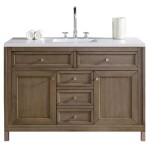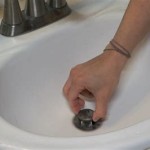Bathroom Vanity With Sink And Top: A Comprehensive Guide
The bathroom vanity with sink and top is a foundational element in any bathroom design, serving as both a functional storage unit and a focal point of the room's aesthetic. Choosing the right vanity involves careful consideration of size, style, material, and configuration to ensure the final product seamlessly integrates with the existing bathroom layout and personal preferences. This article provides a comprehensive overview of the various aspects related to bathroom vanities with sink and tops, covering essential factors to consider before making a purchase.
Understanding the Different Types of Bathroom Vanities
Bathroom vanities are available in a wide array of styles, each offering unique characteristics and advantages. These styles can be broadly categorized into several key types, each influencing the overall look and functionality of the bathroom.
Freestanding Vanities: Freestanding vanities are the most common type and offer a versatile solution for various bathroom layouts. They stand independently on the floor, allowing for easy installation and accessibility for cleaning. These vanities often provide ample storage space and are available in a multitude of styles, from traditional to contemporary.
Wall-Mounted (Floating) Vanities: Wall-mounted vanities, also known as floating vanities, create a modern and minimalist aesthetic. They are installed directly onto the wall, leaving the floor space beneath open. This design enhances the sense of spaciousness and simplifies cleaning. However, proper wall reinforcement is essential to support the weight of the vanity and its contents. Wall-mounted vanities may provide less storage than freestanding options.
Corner Vanities: Corner vanities are designed to fit snugly into the corner of a bathroom, maximizing space utilization in smaller bathrooms. They are particularly useful in bathrooms with limited square footage where a standard-sized vanity might be impractical. Corner vanities typically offer a triangular or curved cabinet design.
Double Vanities: Double vanities feature two sinks side-by-side, making them ideal for shared bathrooms. They provide ample counter space and storage for multiple users, reducing congestion during peak hours. This type of vanity is commonly used in master bathrooms or family bathrooms.
Console Vanities: Console vanities resemble furniture pieces and often feature exposed legs or a decorative frame. They offer a more open and airy feel compared to traditional enclosed vanities. Console vanities combine style with functionality and are available in various materials and finishes.
Selecting the Right Sink and Top Material
The sink and top material significantly impact the vanity's overall appearance, durability, and maintenance requirements. Various materials are available, each possessing unique properties that cater to specific needs and aesthetic preferences.
Solid Surface: Solid surface materials, such as Corian, are known for their durability and non-porous nature. They are resistant to stains, scratches, and bacteria, making them easy to clean and maintain. Solid surface countertops offer seamless integration with the sink, creating a visually appealing and hygienic surface.
Quartz: Quartz is an engineered stone composed of natural quartz crystals and resin. It is highly durable, scratch-resistant, and non-porous, making it an excellent choice for bathroom countertops. Quartz is available in a wide range of colors and patterns, mimicking the look of natural stone without the inherent maintenance requirements.
Granite: Granite is a natural stone renowned for its beauty and durability. Each granite slab is unique, offering a distinctive pattern and color variation. Granite is heat-resistant and scratch-resistant, but it requires sealing to prevent staining and bacterial growth. It is a porous material, requiring maintenance.
Marble: Marble is a luxurious natural stone known for its elegant appearance and veining patterns. However, marble is relatively soft and porous, making it susceptible to scratches, stains, and etching from acidic substances. Marble requires careful maintenance and sealing to preserve its beauty.
Ceramic and Porcelain: Ceramic and porcelain are durable and affordable options for bathroom sinks. They are resistant to scratches, stains, and heat, making them easy to clean and maintain. Ceramic and porcelain sinks are available in various shapes and sizes, offering versatility in design.
Glass: Glass sinks and countertops offer a modern and sophisticated look. Tempered glass is durable and resistant to shattering, but it can be prone to water spots and fingerprints. Glass surfaces require regular cleaning to maintain their clarity.
Key Considerations for Size and Configuration
Choosing the right size and configuration of a bathroom vanity is crucial for ensuring a comfortable and functional bathroom space. Several factors should be taken into account to optimize the vanity's fit within the bathroom layout.
Bathroom Size: The size of the bathroom dictates the maximum dimensions of the vanity. In smaller bathrooms, a compact vanity or corner vanity might be necessary to maximize space utilization. In larger bathrooms, a double vanity or a larger freestanding vanity can serve as a focal point and provide ample storage.
Plumbing Location: The location of existing plumbing fixtures, such as water supply lines and drainpipes, influences the placement and configuration of the vanity. Consider the location of these fixtures when selecting a vanity to minimize the need for extensive plumbing modifications.
Storage Needs: Assess storage requirements to determine the number of drawers, cabinets, and shelves needed in the vanity. Consider the types of items to be stored, such as toiletries, towels, and cleaning supplies, to ensure adequate storage capacity.
Counter Space Requirements: Adequate counter space is essential for placing toiletries, cosmetics, and other personal items. Determine the amount of counter space needed based on usage patterns and personal preferences. Double vanities typically offer more counter space than single vanities.
Accessibility: Ensure adequate clearance around the vanity for comfortable movement and accessibility. Consider the swing of the bathroom door and the placement of other fixtures to avoid obstructions. The Americans with Disabilities Act (ADA) provides guidelines for accessible bathroom designs.
Height: Vanity height is an important consideration for user comfort. Standard vanity heights typically range from 30 to 36 inches. Consider the height of the primary users to choose a vanity height that promotes proper posture and reduces strain. Also, wall mounted vanities gives users the option to mount the vanity for their height preference.
Beyond the functional aspects, the vanity's style should align with the overall aesthetic of the bathroom. Consider the existing color scheme, tile patterns, and hardware finishes when selecting a vanity style. A cohesive design creates a harmonious and visually appealing bathroom space. Styles are categorized as follows:
Traditional: Traditional vanities often feature ornate details, raised panel doors, and classic hardware finishes. They evoke a sense of elegance and formality.
Modern: Modern vanities are characterized by clean lines, minimalist designs, and sleek surfaces. They often incorporate contemporary materials and finishes.
Contemporary: Contemporary vanities blend elements of both modern and traditional styles, offering a balanced and versatile aesthetic.
Rustic: Rustic vanities embrace natural materials, such as reclaimed wood, and feature a weathered or distressed finish. They create a warm and inviting atmosphere.
Transitional: Transitional vanities combine traditional and modern elements, creating a timeless and adaptable design. They are characterized by simple lines and neutral color palettes.
By carefully considering these factors, one can select a bathroom vanity with a sink and top that not only meets functional needs, but also enhances the overall aesthetic of the bathroom.
Installation of a bathroom vanity with a sink and top can be a straightforward process for experienced DIY enthusiasts, but professional installation is often recommended to ensure proper plumbing connections and structural integrity. Proper installation prevents leaks, ensures stability, and protects the warranty of the vanity. During installation, pay attention to the following:
Plumbing Connections: Ensure that all plumbing connections are properly sealed to prevent leaks. Use plumber's tape and pipe dope as needed. Check for leaks after installation by running water through the sink.
Leveling: Ensure that the vanity is level to prevent water from pooling on the countertop and to ensure that drawers and doors operate smoothly. Use shims to adjust the level if necessary.
Securing the Vanity: Secure the vanity to the wall using appropriate hardware to prevent it from tipping or moving. Wall-mounted vanities require additional support to handle the weight of the vanity and its contents.
Caulking: Apply caulk around the edges of the vanity where it meets the wall and floor to prevent water damage and mold growth. Choose a mildew-resistant caulk in a color that complements the vanity.
Hardware Installation: Install hardware, such as drawer pulls and cabinet knobs, according to the manufacturer's instructions. Ensure that all screws are tightened securely.
Proper maintenance and care are essential for preserving the beauty and longevity of a bathroom vanity with a sink and top. Follow these tips to keep the vanity looking its best for years to come.
Regular Cleaning: Clean the countertop and sink regularly with a mild soap and water solution. Avoid using abrasive cleaners, as they can scratch or damage the surface.
Stain Removal: Remove stains promptly to prevent them from setting into the countertop material. Use a stain remover specific to the material of the countertop.
Sealing: Seal natural stone countertops, such as granite and marble, regularly to prevent staining and water damage. Follow the manufacturer's instructions for sealing frequency and application.
Preventing Water Damage: Wipe up spills and water splashes immediately to prevent water damage to the vanity cabinet. Use a bath mat or rug to protect the floor from water damage.
Hardware Maintenance: Tighten loose screws on hardware, such as drawer pulls and cabinet knobs. Replace damaged or worn hardware as needed.
By following these maintenance tips, one can ensure that the bathroom vanity remains in excellent condition for years to come, providing both functionality and aesthetic appeal.

Luxury Classico Sintered Stone Bathroom Vanity Basin Cabinet Grey Width 36cm 40cm 44cm 50cm

Luxury Grande Stainless Steel Bathroom Vanity Basin Cabinet Royal White Width 36cm 40cm 44cm 48cm

Luxury Classico Sintered Stone Bathroom Vanity Basin Cabinet Black Width 36cm 40cm 44cm 50cm

Bathroom Vanities With Sinks Vanity Tops Innovate Building Solutions

Silver Ash Solid Surface Double Sink Vanity Top With Integrated White Sinks

Bathroom Vanity Unit White Oak Top Cabinet With Stone Basin Choice 502gsbc

White Vanity With Cultured Marble Top And Sink 48 5 Singapore U

Modern 800mm Floating Vanity Sink For Bathroom Single Vessel Cabinets Homary

Luxury Classico Vanity Basin Cabinet Full Black Colour

Vapsint 29 In W X 20 D 27 H 2 Doors Bathroom Vanity White With Ceramic Sink Top Va Bc033ygw Qd Qg Jlj174a







